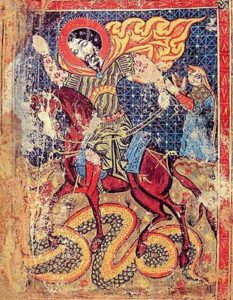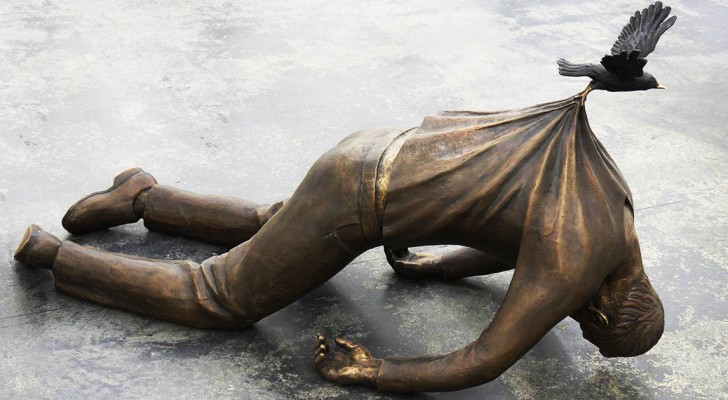 St. George has been classed from the beginning among the greatest saints and martyrs of the Christian Church. In spite of his popularity both in the East and in the West, we do not know much about his life, except that he was a high ranking military officer in the Roman Army towards the end of the third century. He was a brave soldier, as well as a virtuous Christian. He openly protested against the persecutions of Christians ordered by the Emperor Diocletian. He was bold enough to tear down the imperial order of persecution which was posted in the streets of Antioch. He was summoned before the imperial court for this crime. He bravely defended his religion and showed the falsehood of paganism, as well as the injustice of the order of persecutions. For his outspoken courage, he was beheaded after terrible tortures in the year 303.
St. George has been classed from the beginning among the greatest saints and martyrs of the Christian Church. In spite of his popularity both in the East and in the West, we do not know much about his life, except that he was a high ranking military officer in the Roman Army towards the end of the third century. He was a brave soldier, as well as a virtuous Christian. He openly protested against the persecutions of Christians ordered by the Emperor Diocletian. He was bold enough to tear down the imperial order of persecution which was posted in the streets of Antioch. He was summoned before the imperial court for this crime. He bravely defended his religion and showed the falsehood of paganism, as well as the injustice of the order of persecutions. For his outspoken courage, he was beheaded after terrible tortures in the year 303.
St. George is always represented in pictures as a horseman killing a monster or dragon. This is symbolic, representing St. George fighting against the powers of evil, against injustice, and for the liberty of human conscience. However, Christian imagination has invented stories about St. George fighting with a real dragon. According to one of the most widely spread stories, a terrible monster had overrun the countryside around a certain city. The monster inhabited a cave nearby. Its breath alone caused pestilence (disease/death) whenever the monster approached the town. The inhabitants, finding themselves helpless against this monster, had lambs every day to satisfy its hunger and to keep it in its cave. But eventually there was no lamb or sheep or goat left in the town or in the vicinity and they were obligated to offer human beings to the dragon. Lots were cast (like drawing straws) to determine the victim.
On one occasion when the lot was cast, as usual, it fell on a daughter of the Governor of the city. The Governor offered all his wealth to purchase a substitute, but the people had pledged themselves that no substitutes should be allowed. Therefore, the poor maiden dressed as a bride, was led to the cave of the monster. As they were taking the daughter of the Governor out of town, St. George was passing by and seeing the poor girl crying so helplessly, asked the reason. Learning the cause, he decided to fight and kill the dragon. So he alone followed the maiden to the entrance of the cave. The maiden, requested him to leave, so he wouldn’t be killed. St. George, however, prepared himself to meet the monster. When the dragon appeared, St. George, making the sign of the cross, attacked the monster and nailed it to the ground with is lance, and then dragged it to the city like a wooden log. When the townsfolk saw the dragon, they were so terrified that everybody ran away. But St. George ordered them to have no fear, but believe in the true God, and in Jesus Christ, “through whose power,” he said, “I killed this dragon.” Then he cut off the head of the dragon to make everybody realize that it was no longer a dangerous monster. The townsfolk, seeing the supernatural power of St. George, were converted to Christianity and were baptized.
The Governor and his wife were so happy at the miraculous rescue of their daughter, that they offered half of their possessions and wealth to St. George. But the saint, thanking them for the offer, replied that his mission was to go from place to place and to save the helpless people like their daughter. “Only I would ask of you,” he said, “to protect all Christians under your rule, honor their clergy, and have pity on and take good care of all poor people.” He then went off to carry on his God-given mission.
Commonly when we think about Saints, we are apt to think of pale, quiet persons, who think about nothing else but their salvation and heavenly bliss. This is not always a true picture of a saint. A true saint is a person of strong convictions. He is a man of action, a real fighter. St. George is the best example of this kind of active saintliness. His example and courage should inspire us to become better fighting members of the Church, fighting against falsehood and evil.

